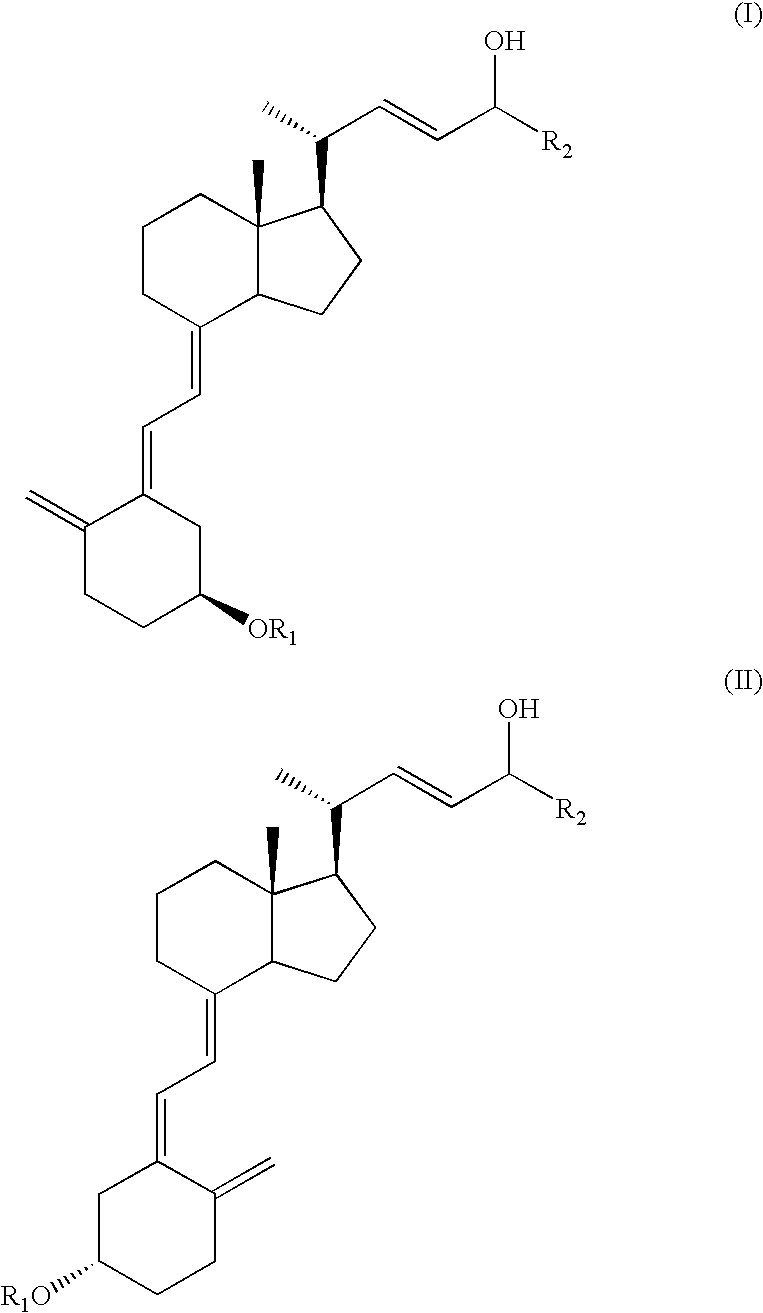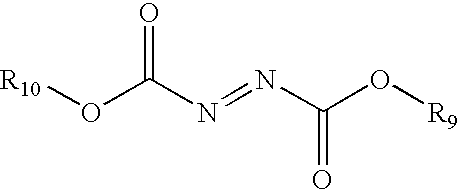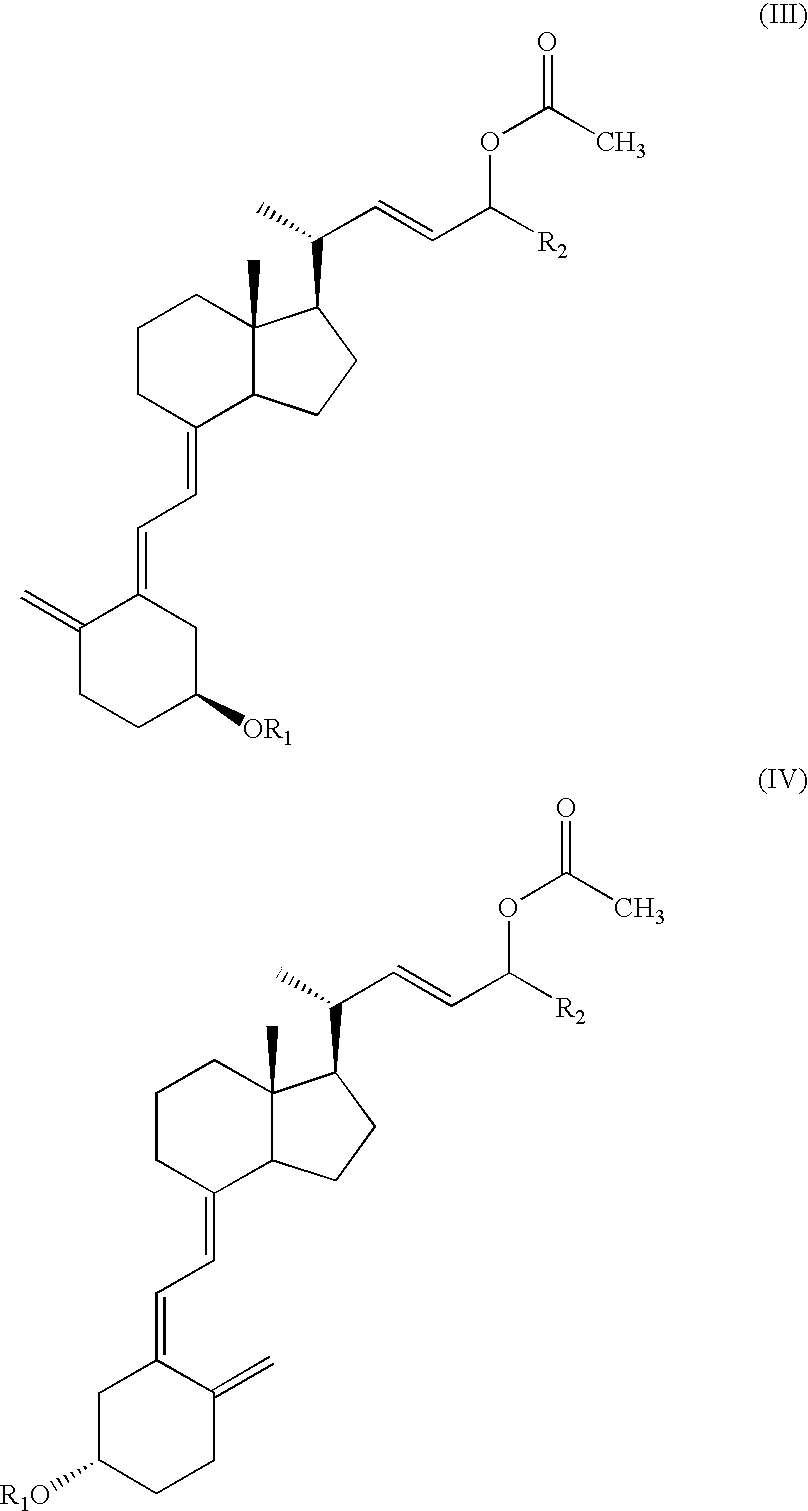Selective enzymatic esterfication and solvolysis of epimeric vitamin D analog and separation and epimerization of the epimers
a technology of enzymatic esterfication and solvolysis, which is applied in the field of purifying a mixture of epimers, can solve the problems of low efficiency of separation by direct chromatography, high cost of the reagents for the reactions illustrated above, and inability to easily apply mass production, etc., to achieve the effect of reducing the amount of waste side products, reducing manufacturing costs, and increasing total yield
- Summary
- Abstract
- Description
- Claims
- Application Information
AI Technical Summary
Benefits of technology
Problems solved by technology
Method used
Image
Examples
example 1
Selective Enzymatic Esterification
[0051] To a stirred solution of C-24 epimeric alcohol mixture (56:36 diastereomer ratio) of formula (I) [wherein R1=tert-butyldimethylsilyl and R2=cyclopropyl] (10 g, 19.5 mmol) and vinyl acetate (10 ml, 107.5 mmol) in hexane (10 ml) is added 1.0 g Alcaligenes sp. lipase. The mixture is stirred for 48 hours at 35±5° C. after which time the HPLC analysis shows essentially complete conversion of epimer C-24(R) to the acetate. The remaining nonesterified C-24(S) alcohol shows >90% diastereomeric excess (by HPLC). The solution is filtered and concentrated to dryness. The residue is chromatographed on pre-treated silica gel with 6.0% ethyl acetate in hexane and then ethyl acetate to give C-24 acetoxy compound (IIIa) (5.4 g) and C-24 alcohol compound (Ib) (2.3 g).
[0052] C-24 acetoxy compound (IIIa): NMR (200 MHz, CDCl3) δ 2.05(s, 3H, CH3), 3.80˜3.85(m, 1H, 3-H), 4.62˜4.70(m, 2H, 19-H&24-H), 4.90(s, 1H, 19-H), 5.28˜5.39(m, 1H, 22-H), 5.41˜5.63(m, 1H, 23-...
example 2
Selective Enzymatic Esterification
[0054] The procedure of Example 1 is repeated, except that 1.0 g of Alcaligenes sp. Lipase is immobilized onto 4 g Eupergit C (Rohm, Germany) according to a known procedure recommended by the supplier and that the molar quantities of the reagents are changed. In this example, 0.6 g (1.17 mmol) of compound of formula (I), 11.0 ml (10.8 mmol) vinyl acetate, 1 ml hexane, and 1 g of immobilized enzyme are contained in the mixture. The mixture is stirred at 35° C. for 6 hours, after which time the HPLC analysis shows the presence of 30% C-24(R) epimeric alcohol mixture (Ia), 35% C-24(R) acetoxy compound (IIIa) and 35% C-24(S) alcohol compound (Ib).
example 3
Selective Enzymatic Esterification
[0055] Repeat the procedure of Example 1, but use 2 mL diisopropyl ether to replace the organic solvent used in Example 1. In this example, 1 g (1.95 mmol) of compound of formula (I), 2 ml (21.6 mmol) vinyl acetate, 2 mL diisopropyl ether, and 100 mg of Alcaligenes sp. Lipase are contained in the mixture. The mixture is stirred at room temperature for 42 hours, and after which time the HPLC analysis shows the presence of 56% C-24(R) acetoxy compound (IIIa) and 35% C-24(S) alcohol compound (Ib).
PUM
| Property | Measurement | Unit |
|---|---|---|
| temperature | aaaaa | aaaaa |
| temperature | aaaaa | aaaaa |
| temperature | aaaaa | aaaaa |
Abstract
Description
Claims
Application Information
 Login to View More
Login to View More - R&D
- Intellectual Property
- Life Sciences
- Materials
- Tech Scout
- Unparalleled Data Quality
- Higher Quality Content
- 60% Fewer Hallucinations
Browse by: Latest US Patents, China's latest patents, Technical Efficacy Thesaurus, Application Domain, Technology Topic, Popular Technical Reports.
© 2025 PatSnap. All rights reserved.Legal|Privacy policy|Modern Slavery Act Transparency Statement|Sitemap|About US| Contact US: help@patsnap.com



